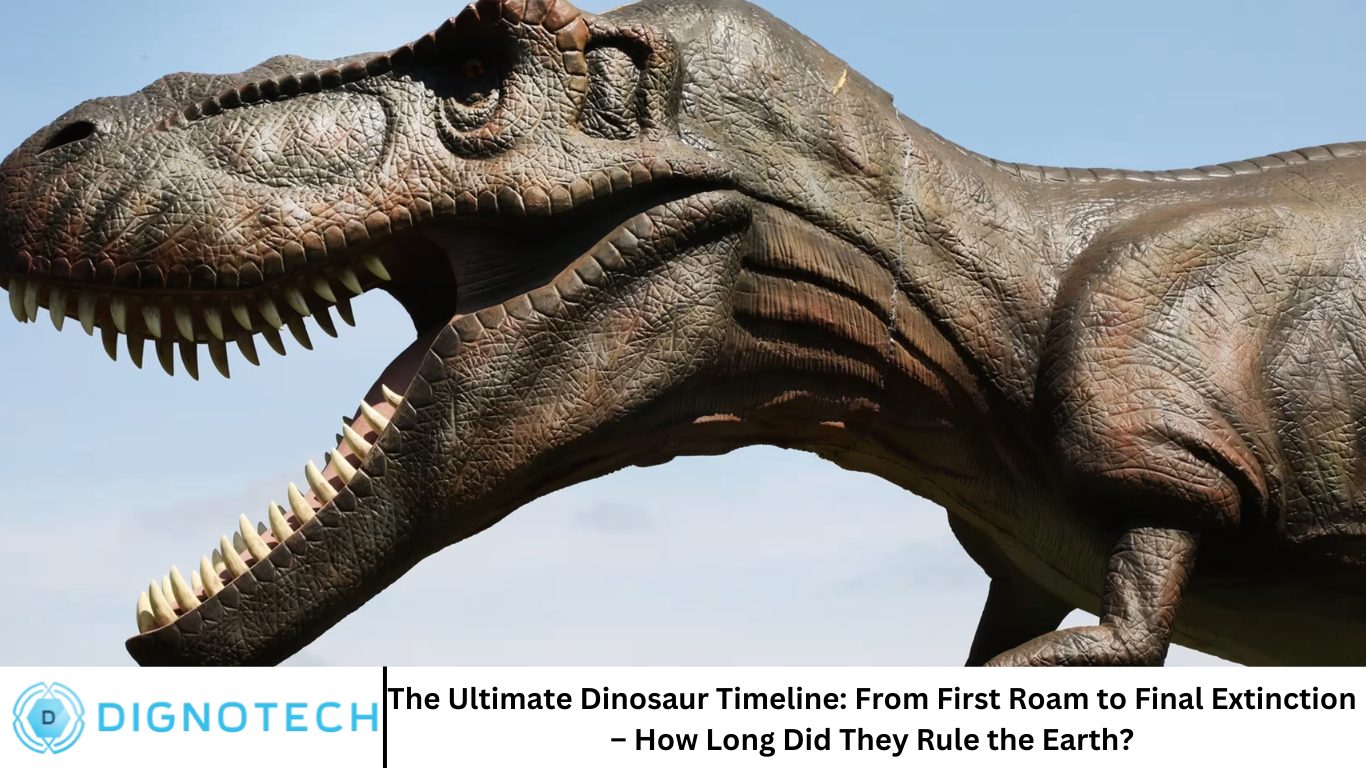The Ultimate Dinosaur Timeline: From First Roam to Final Extinction – How Long Did They Rule the Earth?

Hi everyone! How are you all doing? Welcome to dignotech.com! Dinosaurs have always captivated our imaginations with their immense size, strange shapes, and fascinating history. From the earliest ancestors of these mighty creatures to their sudden extinction, the journey of dinosaurs spans millions of years. Understanding this timeline not only uncovers the mystery of their rise and fall but also helps us comprehend how life on Earth evolved over time.
In this article, we will dive deep into the timeline of dinosaurs, exploring their origins, dominance, and eventual extinction. Along the way, we will address the various periods of time in which they thrived and how the Earth itself changed. At the end, we will answer the seven most frequently asked questions about dinosaurs and their reign over the planet.
The Mesozoic Era: The Age of Dinosaurs
The history of dinosaurs is deeply tied to the Mesozoic Era, which lasted for about 180 million years. This era is divided into three major geological periods: the Triassic, Jurassic, and Cretaceous. Each period brought about new evolutionary developments for dinosaurs, as well as significant changes to the Earth’s landscapes and climates.
The Triassic Period (252-201 Million Years Ago)
The Triassic Period marked the dawn of the dinosaurs. This era began roughly 252 million years ago, following the largest mass extinction event in Earth’s history—the Permian-Triassic extinction. This cataclysmic event wiped out over 90% of life on Earth, providing opportunities for new species to evolve.
Early Dinosaurs
Dinosaurs didn’t immediately dominate the planet; they began as small, often nocturnal creatures. The first dinosaurs were bipedal and relatively small in comparison to the giants that would appear later in the Mesozoic Era. Early species like Eoraptor and Herrerasaurus were carnivorous and hunted small animals, while others like Plateosaurus were herbivores, grazing on plants.
At the same time, other reptiles, including crocodile-like animals and giant amphibians, were still present and thrived in the Triassic landscape. It wasn’t until the middle to late Triassic that dinosaurs began to rise in prominence. Over millions of years, their body sizes, shapes, and behaviors began to diversify.
Earth’s Changing Environment
The Triassic Period was characterized by a hot, dry climate, with vast deserts covering much of the land. The continents were still largely joined together, forming a supercontinent known as Pangaea. This massive landmass began to break apart toward the end of the Triassic, setting the stage for the Jurassic Period. The changing climate and landmass shifts played a significant role in the evolution of dinosaurs and other life forms.
The Jurassic Period (201-145 Million Years Ago)
The Jurassic Period saw the true rise of the dinosaurs, with many of the most famous species emerging during this time. As Pangaea continued to break apart, the Earth’s climate began to become more humid and temperate, leading to the growth of lush forests and vast plant life. These new environments provided plenty of resources for herbivorous dinosaurs, which, in turn, supported the carnivores that hunted them.
The Age of Giants
The Jurassic is often referred to as the “Age of Giants” due to the enormous size of many dinosaurs that evolved during this period. Sauropods like Brachiosaurus and Apatosaurus roamed the Earth, growing up to 100 feet long and weighing as much as 50 tons. These massive herbivores had long necks, which allowed them to reach tall trees and consume vast amounts of vegetation.
Carnivorous dinosaurs like Allosaurus and Megalosaurus were also dominant during the Jurassic. These predators hunted the large herbivores, and their sharp teeth and claws made them efficient hunters. This period also saw the development of the first birds, which evolved from small theropod dinosaurs.
The Evolution of Plant Life
During the Jurassic, plant life became more diverse. The first flowering plants appeared, alongside ferns, cycads, and conifers, which dominated the landscape. These plants provided the primary food source for herbivorous dinosaurs, helping fuel the growth of massive sauropods and other large herbivores.
Earth’s Shifting Continents
Pangaea’s breakup continued throughout the Jurassic Period. The continents drifted farther apart, leading to the creation of distinct ecosystems. This caused isolated populations of dinosaurs to evolve into unique species suited to their environments. The increased fragmentation also helped accelerate the rise of different species across the globe.
The Cretaceous Period (145-66 Million Years Ago)
The Cretaceous Period marked the final chapter in the age of dinosaurs. This period saw the peak of dinosaur diversity, with some of the most well-known species appearing, including Tyrannosaurus rex, Triceratops, and Velociraptor. The world was a very different place from the one seen during the Triassic, with lush forests, massive inland seas, and increasingly complex ecosystems.
The Rise of New Species
During the Cretaceous, dinosaurs continued to evolve into many forms. Herbivores like Triceratops and Ankylosaurus developed advanced defenses such as horns, armor, and thick, protective skin to defend themselves against predators. Carnivores like Tyrannosaurus rex grew to enormous sizes, becoming apex predators in their environments.
The Cretaceous also saw the emergence of new types of reptiles, such as marine reptiles like Mosasaurus and Plesiosaurus, and flying reptiles like Pteranodon. These animals filled niches in the oceans and skies, showing that dinosaurs weren’t confined to land.
The Earth’s Climate and Geography
The Earth’s climate during the Cretaceous was warmer than today, with no polar ice caps and higher sea levels. The increased warmth allowed plant life to flourish, supporting a diverse array of herbivorous dinosaurs. The landmasses of the Earth were also well separated, and shallow seas separated continents, creating new marine environments for life to thrive.
The End of the Dinosaurs: The Cretaceous-Paleogene Extinction Event
At the end of the Cretaceous, around 66 million years ago, a massive extinction event struck, wiping out the dinosaurs in what is now known as the Cretaceous-Paleogene (K-Pg) extinction event. This event is believed to have been triggered by a combination of factors, including a massive asteroid impact near what is now the Yucatán Peninsula in Mexico, as well as volcanic activity and climate changes. The impact released an enormous amount of energy, causing fires, tsunamis, and a dramatic cooling of the Earth’s climate.
This sudden environmental change led to the extinction of roughly 75% of life on Earth, including nearly all dinosaur species. While some smaller dinosaurs and other creatures survived, the age of the dinosaurs came to a close, marking the end of their 180-million-year reign.
Frequently Asked Question
How long did dinosaurs live on Earth?
Dinosaurs lived on Earth for approximately 180 million years, from the Triassic Period (about 230 million years ago) until their extinction at the end of the Cretaceous Period (about 66 million years ago).
What caused the extinction of the dinosaurs?
The most widely accepted theory is that a combination of an asteroid impact and volcanic activity led to dramatic environmental changes, including a “nuclear winter” scenario with a sharp drop in temperatures. This event is known as the Cretaceous-Paleogene extinction event.
What was the largest dinosaur?
The largest dinosaur ever known is the Argentinosaurus, a sauropod that reached lengths of over 100 feet and weighed as much as 100 tons. It lived during the Late Cretaceous Period in what is now South America.
Were dinosaurs warm-blooded or cold-blooded?
The exact metabolism of dinosaurs is still debated, but evidence suggests that some dinosaurs were warm-blooded (endothermic), especially smaller theropods like Velociraptor. Larger dinosaurs may have been more cold-blooded (ectothermic), but the metabolism likely varied among species.
Did dinosaurs live in all parts of the world?
Yes, dinosaurs lived on every continent. The breakup of Pangaea allowed different species to evolve in isolated ecosystems, leading to the wide diversity of dinosaurs seen across the globe.
Did any dinosaurs evolve into birds?
Yes, birds are the descendants of small theropod dinosaurs. The transition from dinosaurs to birds is well-documented in fossils, with key features like feathers and certain skeletal structures helping establish this evolutionary link.
What was the first dinosaur?
The first dinosaurs appeared in the late Triassic Period, around 230 million years ago. The earliest known dinosaurs include Eoraptor and Herrerasaurus, both of which were small, bipedal, and carnivorous.
Conclusion
The timeline of dinosaurs spans an incredible length of time, from their early origins in the Triassic Period to their extinction at the end of the Cretaceous. Throughout this era, dinosaurs evolved into a wide variety of forms, becoming the dominant creatures on Earth for over 180 million years. The end of the dinosaurs was as dramatic as their rise, with a catastrophic event that wiped out nearly all life on Earth. Today, we continue to study these ancient creatures, and through fossil evidence and scientific research, we continue to uncover more about the life and death of the dinosaurs that once ruled the Earth.





